#places to visit in Nagaland in October
Explore tagged Tumblr posts
Text
Discover Dzukou Valley: Northeast India's Hidden Gem
Discover Dzukou Valley: Northeast India's Hidden Gem 🏞️ Explore the breathtaking Dzukou Valley in Nagaland, India! Home to 500+ rare plant species, vibrant wildflowers, and the elusive Blyth's tragopan pheasant. Perfect for trekkers, nature lovers, and photographers. Best time to visit: May-October. #DzukouValley #NortheastIndia #Trekking #NatureLovers #AdventureTravel
Nestled in the heart of Northeast India, Dzukou Valley is a breathtaking natural wonder that has captured the hearts of adventurers and nature enthusiasts alike. This hidden gem, straddling the borders of Nagaland and Manipur, offers a mesmerizing blend of lush meadows, vibrant flora, and unforgettable trekking experiences. Prepare to be swept away by the valley’s serene beauty and unique…
#adventure#Dzukou Valley trek#hiking#Nagaland hidden gems#places to visit in Nagaland in October#tourism#Travel#Trekking
0 notes
Text
Travel Sketches (Nov 2023 - March 2024)
Nov 2023.
Bishnumaya just turned 100 this October. She comes from Pokhari, about 15 kilometers from Mirik town. As we spoke, she recalled old memories, her expressions shifting as if reliving those moments. She seemed elsewhere, gazing past me into the distance, and then, as if continuing a conversation with herself, she said, “Nowadays people ask about caste when they meet someone, and how is that of any use?”
She described how, when she was small, there were no proper schools in her village. She learned to read and write, however little, by arranging corn kernels on the ground to form shapes that resembled letters and numbers. Reflecting on her long life, she added that everyone around her—friends her age and younger siblings—is dead, and she feels like a monster who swallowed them all.

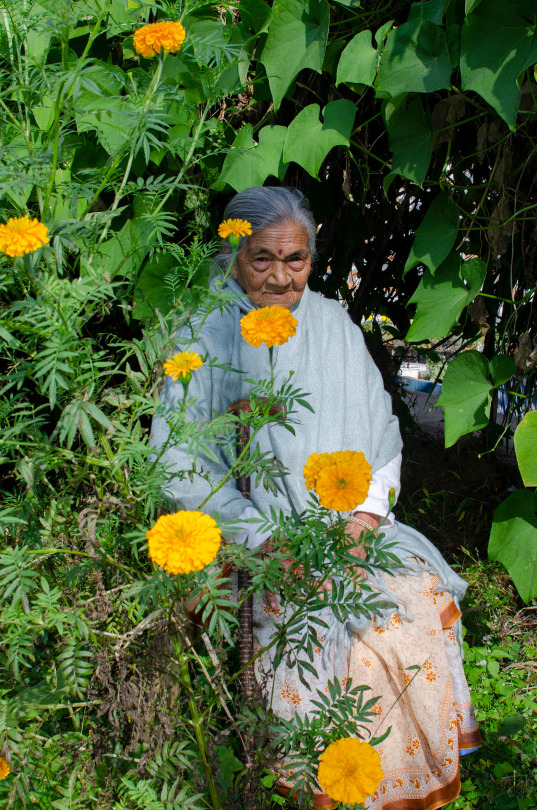

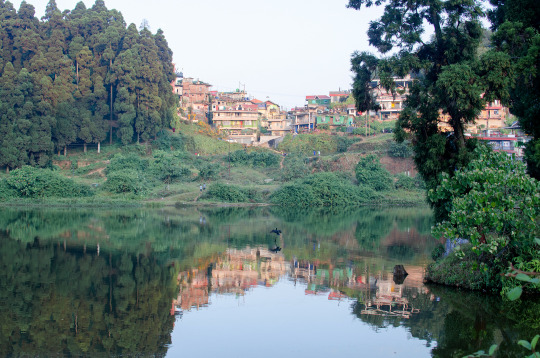
The sun is out, but it’s only warm where the light falls. The history of Mirik is reflected in its lake, which used to be a marshland. According to Wikipedia, the name Mirik comes from the Lepcha words Mir-Yok, meaning "place burnt by fire." It's very green now for a place that was once burnt.
A town fair is underway, offering a range of attractions: a Ferris wheel, flower park visits, fast food stalls, ice cream carts, horse and boat rides, live pop music, card game betting, balloon shooting, local bingo-type card games, and hoopla with prizes up for grabs. Some prizes are cash with notes of 20, 50, and 100 rupees.

——
For the past ten years, I haven't had a permanent home. When I wanted to sidestep the weight of planning and longed for comfort and familiarity, I returned to places I liked a little more than others: Auroville, Dharamshala, Shillong, Aizawl, Nagaland.
I like meeting new people and have formed what feels like extended families in some of these places. Since I have mostly felt free to move around, sometimes nostalgia of people or a time or a curiosity to see how things may have changed would draw me back to a place.
Earlier in August, while I was temporarily living in Auroville, I got a call about a six-month project called The Great Himalayan Exploration, a collaboration between UNESCO and Royal Enfield. The project aims to document the intangible cultural heritage of local communities in the Himalayan region of Northeast India.
My work on this trip specifically involved photographing the people behind various cultural practices and examining the ecosystems they exist in. To build context, I engaged in various methods, such as scanning old photos from people’s personal albums, taking photos of their living spaces, landscapes, and exploring archival resources. From November to April, we were in West Bengal, Sikkim, Tripura, Mizoram, Assam, Nagaland, and Meghalaya.
------

On our way back to Siliguri from Mirik, we made a lengthy stop near a tea estate. Lalita, from Tingling village, shared that she had spent two decades working on the estate, much like many other women from the village. Their collective hope was to earn a minimum of 500 rupees per day for their labor. Currently, they are receiving 250 rupees per day for an eight-hour shift.
------


Sanchamaya, 74, sits with her friend Bodhimaya in the front yard of her house in Darap, both lifelong farmers of the area and belonging to the Limbu community. They're nice and welcoming. It's our second day in Pelling, West Sikkim, and I've ended up at the wrong house. Today, we're supposed to see a drum dance(chyabrung) performance by local Limbu boys, which I'll catch later.
They talk in basic broken Hindi, with Shusan translating most of it. Sanchamaya leads me to the back of their house, where she proudly shows me trays of dried large cardamoms. Later, we'll visit her cardamom field. They also cultivate Mosambi, oranges, guavas, maize, peas, ginger, and onions. Sanchamaya spends her days with her friend, grandchildren, working in the fields, and cooking in the kitchen.


------
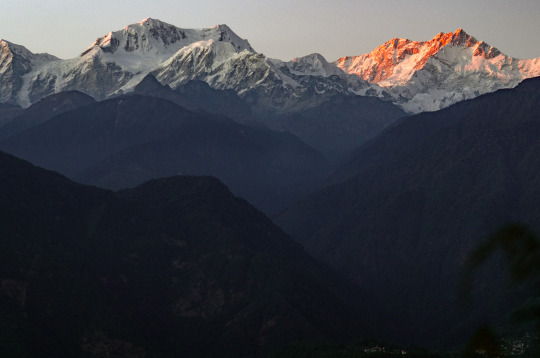

I visited Chuba village, 3 hours away from Gangtok, with Semeon from Haflong, Assam, a textile design graduate from NID and working at Sonam’s design studio called EchoStream based in Gangtok. Semeon was familiar with the village and the community I was there to meet. Arun Gurung and his wife, founders of Chubako, are endeavoring to revive an old tradition of sourcing wool from indigenous banpala sheep to make clothes. They operate a small cooperative called Chubako. In this village of 43 families, one person from each household now works for Chubako. (photo above: Arun Gurung, founder of Chubako)
(photo below: Designed by Sanskruti Shukla, co-created with the craft community of Chubako for Echostream, Gangtok)
Local stories of the craftspeople of Chuba are showcased and incorporated into wool through interactive workshops focused on storytelling and design development. The felted art rugs depict the flora and fauna of Sikkim.


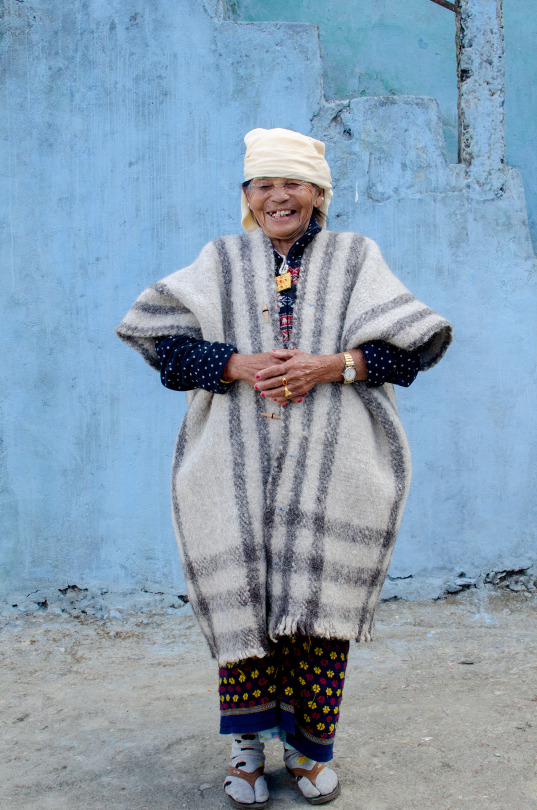
Gangamaya Gurung, 83, Arun Gurung's mother, lit up like a child when she saw Semeon. They shared a bond akin to best friends. Despite her age, Gangamaya remains active, tending to sheep, cutting grass, farming, and weaving. When asked about her leisure activties, she said, "eat, watch TV - eat, watch TV."
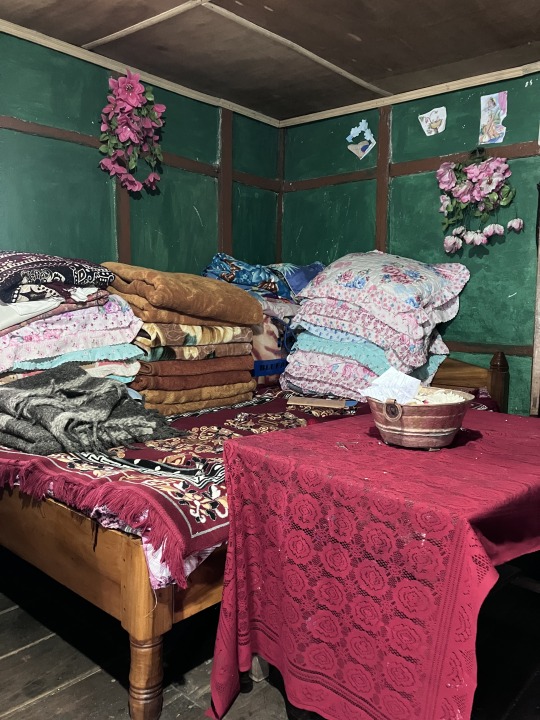


Sampati Debbarma, a farmer, returning from work in Takarjala, Tripura.
--------
Jan, 2024.
We have been out on this trip for 3 months. My thoughts scattered in a kind of bardo between the world I know and the world I am coming into contact with. I picture house fronts with flowers in Darjeeling, roads winding, the long cold rivers snaking toward mountains that seem no bigger than my thumb, the snow capped peaks shifting colours, the prayer flags in high altitudes and on house doors. Gangtok’s Lal Bazaar skateboarders flash by, a school in Tripura where a student lives on 700rs a month, nini bung tamo and 4 other sentences I learned in Kokborok nag me like a tune. Sidangcherra to Pecharthal to Panisagar to Damchara checkpoint we make our way from Tripura into Mizoram by road. I think about where I will be later in the summer and see a white fluffed cloud taking the shape of a growing tree far on the horizon.
——
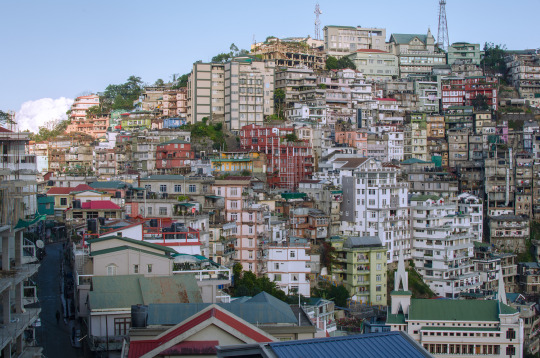
Krismas Ruaitheh(Christmas feast) at Khatla Presbyterian Church, Aizawl. This is my 3rd time in Aizawl. I used to go for dinners, sometime evening tea to my friend’s family house further up the road from the Khatla church. We are here to document the traditional community feast of the Mizos.

Priscilla is currently pursuing her BA in Political Science in Delhi, and she's home for the holidays. She was volunteering at Khatla Presbyterian Church where she and her friends were tasked with serving lemonade, a customary drink after the meal. For Priscilla, the most remarkable aspect of the feast is its longstanding tradition — dating back to pre-Christian times — where the entire community comes together to share its moments of joy and sorrow + they still use Changel Hnah (plantain leaves) — the traditional way to serve meals.
-----

On an idle walk one evening in Khatla, I find myself in a local thrift store and get invited to meet James Lalhmingliana. He is 80, one of the founding members of Aizawl's first bike club, Aizawl Thunders. He went to school at Sts. Edmund’s in Shillong.
In 1966, he joined the Mizo National Front uprising, fighting for freedom. He went underground for seven years, first in Arakan, Burma, then in 1969 to East Pakistan for shelter. "It was useless," he says. "We wasted our good years. When I came back, I was put in jail, but not for long."
He has been housebound for years due to his health.
———


At 8 am on a cold January morning, we arrive at Joonbeel Mela. (Joon and beel are Assamese terms for moon and wetland. The Tiwa community first organized this in the 15th century to exchange goods between indigenous tribal communities in Assam and the surrounding areas.)
It is known as the only fair in India where people still practice barter, exchanging goods like fish, sweet potatoes, yam, homegrown vegetables, turmeric, chili, kali miri, and rongalau.
Over a few hours, I have brief interactions with people from Jagiroad, Pamlatar, Deosal, Sira, Changsari, Potia Pathar, Bengenabari, Palahguri, ulukunchi, morigaon, Nagaon, Saru Amli, Belguri, Damal, and places as far as Langpih, mawlynnong in Meghalaya. No one refuses a photo.
—

This is my fifth time in Nagaland. I first came here ten years ago and stayed at Kevesho's home. He is the father of the Tetseo Sisters, a well-known folk group of four sisters from Nagaland.
Kevesho Tetseo, son of Nülhüprü Tetseo was born in 1950s in Thüvopisümi village, Phek District, Nagaland. Initially schooled in the village, he finished his HSLC at Government High School in Kohima and graduated from Kohima College in Arts. He worked in the Education Dept. for sometime and now retired. Active in cultural music, Chokri language preservation, and in church choir since his youth.
(Tati - - a single string musical instrument which is used as an accompaniment with singing of li- indigenous songs by the Chakhesang Nagas.)
Kevesho learned how to make Tati from observing elders in his village when he was young and has done Tati making work since 1990s and a good number of it has been produced till date by him including improvising it for longer life by using steel wires as strings.
He tells me, the woven shawl he is wearing in the picture is "thipiqhü". It is the most prestigious shawl (indigenous cloth) among many traditional clothes of the Chakhesang tribe. It is a shawl they wear with humility and honour.
“Nagaland is my home and I love my culture, its rich traditional heritage, and the natural beauty.”
-----

Daisy Yaden was born in Zotlang, Mizoram. She studied at the Welsh Mission School in Mission Veng, Aizawl. She will turn 98 this June. She learned to weave shawls on a backstrap loom, stitching, and baking from her mother, often baking cakes in the fireplace. She taught in the interiors of Nagaland, in places like Noklak and Changtongya. She started her career by teaching people self-sufficiency—how to cook, make jams and pickles—skills she picked up from a British magazine called Woman’s Own. She used to compose little tunes for children at Sunday school. She loves flower gardening and her favourite film is "Gone with the Wind."
Photographed at her house in Duncan, Dimapur.

I am sitting with Marian, Daisy's daughter, at her house in Duncan. Marian, now 75, lived in Bombay from 1970 to 2012. She went to college there and worked as an air hostess with Air India for 34 years. In 2012, she returned to Nagaland. We agreed to meet again for lunch and look at her old photo albums.
(below: Marian,16, in Kohima trying a sari for the first time / in Santa Cruz, Bombay in the 80s with James Ferreira and friends)



——-

Khinchi is Christian, and Sindri is Songsarek, belonging to one of the last animism practising communities. I learned a few words in Achik: Khading bo, Methela, Namja, and Manja. Here I am in the extended kitchen space at Sindri's hut, in Sadolpara, Dadenggre, where they are taking a break from cooking lunch.
-----
First published in Hindustan Times June '24
1 note
·
View note
Text
Best Time to Visit Benreu for an Unforgettable Experience
Tucked away in the serene hills of Nagaland, Benreu is an untouched paradise that offers travelers a mix of nature, culture, and adventure. Known for its rich tribal heritage, scenic landscapes, and unique local flavors, Benreu tourism is gaining popularity among explorers seeking offbeat destinations.
Whether you’re looking for things to do in Benreu, exploring its famous temples, or enjoying its tranquil environment, choosing the best time to visit Benreu can significantly enhance your experience. This travel guide will provide essential details on Benreu weather, how to reach Benreu, and the top places to visit in Benreu.

Best Time to Visit Benreu
Benreu enjoys a moderate climate throughout the year, but the ideal time to visit depends on your travel preferences.
1. Summer (March to May) – Pleasant and Refreshing
Temperature: 15°C to 25°C
Ideal for sightseeing and exploring Benreu tourism
Perfect time for trekking and village tours
2. Monsoon (June to September) – Green and Beautiful
Temperature: 18°C to 22°C
Lush greenery but heavy rains may hinder travel
Not recommended for trekking due to slippery trails
3. Winter (October to February) – Chilly and Mystical
Temperature: 5°C to 15°C
Best time for cultural experiences and festivals
Clear views of the surrounding mountains and valleys
Best Time to Visit: October to April for clear skies, cultural events, and adventure activities.
How to Reach Benreu
Reaching Benreu requires a mix of air, rail, and road travel as it is a remote village in Nagaland.
By Air
The nearest airport is Dimapur Airport (120 km)
Direct flights from Kolkata, Guwahati, and Delhi
From Dimapur, hire a cab or take a local bus to Benreu
By Train
The closest railway station is Dimapur Railway Station
Well-connected with Guwahati, Kolkata, and New Delhi
Further travel by road is required to reach Benreu
By Road
Well-connected to Kohima (80 km) and Dimapur (120 km)
Private taxis and state-run buses are available
Tip: Hiring a private cab from Kohima is the most convenient way to reach Benreu.
Top Places to Visit in Benreu
Benreu offers breathtaking landscapes, cultural experiences, and spiritual sites.
1. Mt. Pauna
The third-highest peak in Nagaland
Ideal for trekking and nature photography
2. Benreu Village
Known for its Zeliang Naga tribal heritage
Experience traditional village life and local cuisine
3. Ntangki National Park
Home to exotic wildlife like leopards, elephants, and hornbills
A paradise for nature lovers and wildlife enthusiasts
4. Dzüko Valley
Located near Benreu, famous for its picturesque landscapes
Best visited in winter for breathtaking views
5. Famous Temples in Benreu
Though Benreu is predominantly a tribal village, it has sacred sites where locals offer prayers to nature spirits.
Things to Do in Benreu
Benreu offers unique activities that let you explore the region’s culture, nature, and adventure.
Trekking: Explore Mt. Pauna and the surrounding hills
Village Tours: Experience authentic Naga tribal culture
Wildlife Safari: Visit Ntangki National Park
Camping: Spend a night under the stars
Photography: Capture scenic landscapes and cultural moments
Cultural Festivals: Witness Hornbill Festival (December) in nearby Kohima
Benreu Local Cuisine – A Taste of Nagaland
Nagaland’s cuisine is a delightful mix of tribal flavors and exotic ingredients.
Must-Try Dishes in Benreu:
Smoked Pork with Bamboo Shoot – A signature Naga dish
Rice Beer – A locally brewed drink
Axone (Fermented Soybean Curry) – A unique delicacy
Eel Curry – A special dish among the locals
Chutney with Raja Mircha (King Chili) – One of the spiciest chilies in the world
Tip: If you love trying new flavors, don’t miss the local home-cooked meals!
Benreu Weather Overview
Benreu’s climate is generally mild, making it a great destination year-round. SeasonTemperature RangeWeather ConditionsTravel SuitabilitySummer (Mar-May)15°C - 25°CPleasant & DryExcellent for sightseeingMonsoon (Jun-Sep)18°C - 22°CHeavy RainfallNot ideal due to landslidesWinter (Oct-Feb)5°C - 15°CCool & ClearBest for trekking & culture
Conclusion
Benreu is an unspoiled gem in Nagaland that offers a mix of adventure, nature, and cultural experiences. Whether you're a nature lover, adventure seeker, or a culture enthusiast, Benreu tourism has something for everyone. Plan your trip during the best time to visit Benreu for an unforgettable experience, and explore its charming landscapes, traditional villages, and local flavors.
For a hassle-free travel experience, book your trip with Adotrip and explore the beauty of Benreu like never before!
Frequently Asked Questions About Benreu
1. What is the best time to visit Benreu?
The best time to visit Benreu is from October to April, as the weather is clear and ideal for sightseeing and outdoor activities.
2. How can I reach Benreu?
You can reach Benreu via Dimapur Airport (120 km away) or Dimapur Railway Station, followed by a road journey via Kohima.
3. What are the top attractions in Benreu?
The best places to visit in Benreu include Mt. Pauna, Benreu Village, Ntangki National Park, and Dzüko Valley.
4. What local dishes should I try in Benreu?
Don’t miss Smoked Pork with Bamboo Shoot, Axone (Fermented Soybean), Eel Curry, and Rice Beer.
5. Are there any famous temples in Benreu?
Benreu is mainly a tribal village, but it has sacred sites where locals offer prayers to nature spirits.
#Benreu#Benreu travel guide#best time to visit Benreu#Benreu tourism#places to visit in Benreu#famous temples in Benreu#things to do in Benreu#Benreu local cuisine#how to reach Benreu#Benreu weather
0 notes
Text
Top 10 Thrilling Adventure Sports You Should Not Miss in Northeast India
Introduction
Northeast India, often referred to as the "Seven Sisters," is a hidden gem for adventure enthusiasts. With its rugged mountains, dense forests, turbulent rivers, and captivating landscapes, the region offers endless possibilities for adrenaline-pumping experiences. Whether you're a seasoned adventurer or a first-time thrill-seeker, Northeast India has something to get your heart racing.
In this article, we’ll take you through the top 10 adventure sports that should be on your Northeast India bucket list.
1. River Rafting in Teesta and Siang Rivers
Location: Sikkim & Arunachal Pradesh
Best Time to Visit: March to May, October to December
Experience: The Teesta and Siang rivers, fed by melting glaciers, offer some of the best white-water rafting experiences in India. The turbulent rapids range from Grade II to IV, providing a thrilling challenge for both beginners and experienced rafters.
What to Expect: Thrilling rapids, beautiful landscapes, and occasional wildlife sightings along the riverbanks.
2. Paragliding in Gangtok, Sikkim
Location: Gangtok, Sikkim
Best Time to Visit: March to June, September to November
Experience: Soaring over the mesmerizing Himalayan mountains is an unparalleled experience. Paragliding in Gangtok lets you glide like a bird, with breathtaking views of the Kanchenjunga range and lush valleys.
What to Expect: A tandem paragliding session with a trained instructor, lasting from 10 to 20 minutes depending on weather conditions.
3. Trekking in the Dzukou Valley
Location: Nagaland and Manipur border
Best Time to Visit: June to September for lush greenery, October to November for clear views
Experience: Dzukou Valley, also known as the "Valley of Flowers," is a scenic trek that offers everything from dense forests to vibrant flower-strewn meadows. The trek is moderate and ideal for beginners.
What to Expect: Stunning views of the valley, exotic flowers, natural caves, and scenic campsites.
4. Caving in Meghalaya
Location: Shillong, Cherrapunji, and Jaintia Hills in Meghalaya
Best Time to Visit: October to April
Experience: Meghalaya is known for its incredible cave systems, some of the longest and deepest in India. Exploring these limestone and sandstone caves is a thrilling experience, offering a glimpse into ancient rock formations, underground streams, and stalactites.
What to Expect: Adventure and exploration in pitch-dark conditions, squeezing through narrow passages, and discovering underground wonders.
5. Mountain Biking in Arunachal Pradesh
Location: Bomdila, Tawang, and Ziro Valley
Best Time to Visit: April to June, October to November
Experience: The rugged terrains of Arunachal Pradesh make it perfect for mountain biking. With paths cutting through remote villages, lush green forests, and steep valleys, biking here is as challenging as it is rewarding.
What to Expect: Challenging trails, cultural interactions with local tribes, and the raw beauty of Arunachal's landscapes.
6. Rock Climbing in Assam
Location: Elephant Rock near Guwahati
Best Time to Visit: October to March
Experience: For rock climbing enthusiasts, Assam's Elephant Rock provides a great place to test your skills. The natural rock faces vary in difficulty, offering routes for both novice and advanced climbers.
What to Expect: Exhilarating climbs, scenic views, and a unique chance to hone your climbing techniques.
7. Angling in Arunachal Pradesh
Location: Siang and Subansiri rivers
Best Time to Visit: October to April
Experience: Arunachal Pradesh's rivers are home to some of the most prized game fish, like the Golden Mahseer. Angling here combines the thrill of fishing with the tranquility of nature.
What to Expect: Peaceful surroundings, encounters with diverse fish species, and the joy of catching and releasing these majestic fish.
8. Hot Air Ballooning in Meghalaya
Location: Dawki and Umiam Lake, Meghalaya
Best Time to Visit: November to February
Experience: For a unique and relatively new experience, hot air ballooning over Meghalaya's scenic landscapes offers an aerial view of the misty hills, dense forests, and pristine rivers.
What to Expect: A gentle, scenic ride high above, offering panoramic views of the region and a unique perspective of Meghalaya’s stunning landscapes.
9. Ziplining in Cherrapunji
Location: Mawkdok Dympep Valley, Cherrapunji
Best Time to Visit: October to March
Experience: One of the longest zip lines in India, the zip line at Mawkdok Dympep Valley lets you zoom over scenic valleys and lush green hills, giving you a bird's-eye view of the beautiful landscapes.
What to Expect: A thrilling ride over the valley, high adrenaline, and a memorable experience.
10. Camping and Jungle Safari in Kaziranga National Park
Location: Assam
Best Time to Visit: November to April
Experience: Famous for its one-horned rhinos, Kaziranga National Park offers camping and safari options for wildlife enthusiasts. Safaris can be done by jeep or elephant, giving you a chance to witness exotic wildlife in their natural habitat.
What to Expect: Close encounters with rhinos, tigers, and other wildlife, scenic campsites, and the tranquility of being surrounded by nature.
Conclusion
Northeast India is a treasure trove of adventure activities that appeal to every kind of thrill-seeker. From white-water rafting to paragliding, trekking, and wildlife safaris, this region offers experiences that are truly one of a kind. Each sport brings you closer to the region's unique landscape, rich culture, and vibrant biodiversity. So pack your bags, lace up your boots, and prepare for an unforgettable adventure in the enchanting landscapes of Northeast India. You can rent a self drive car for explore wisely.
0 notes
Text
Unveiling 6 Offbeat Destinations: Take a Short Trip in India in 2023
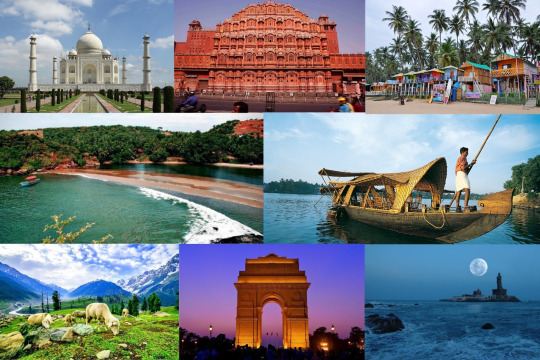
Embarking on a short trip in India allows you to discover emerging offbeat destinations. If you are tired of visiting the same famous tourist destinations in India, this time use your weekend effectively to immerse yourself in the charm of the lesser-explored wonders of India. For explorers like you, we have penned down the 6 best offbeat destinations in India that offer a delightful escape from the hustle and bustle of everyday life.
1. Dhanushkodi, Tamil Nadu: Dhanushkodi, located on the southern tip of Rameswaram Island, offers a mystical experience where the Indian Ocean and Bay of Bengal meet. Visit the iconic Adam's Bridge, the ruins of the old town, and the Gandhamadhana Parvatham for panoramic views. The beach, with its pristine beauty, provides a serene environment for relaxation and introspection. Explore our weekend trip packages that will make your trip economical.
Best Time to Visit: November to February
2. Gokarna, Karnataka Tucked away on the western coast of Karnataka, Gokarna is a tranquil beach town known for its pristine shores and spiritual significance. It is one of the best vacation spots near Bangalore to visit with friends on the weekend. Explore the scenic beaches like Om Beach and Paradise Beach, witness the breathtaking sunsets, and visit the revered Mahabaleshwar Temple. Gokarna offers a perfect escape from the city, making it an ideal destination for a short trip in India.
Best Time to Visit: October to March
3. Ziro, Arunachal Pradesh One of the best vacation spots in Northeast India for peace seekers and nature lovers, Ziro in Arunachal Pradesh is a hidden gem for those seeking offbeat vacation spots. It is nestled amidst the mesmerising Eastern Himalayas and showcases a delightful blend of natural beauty and cultural richness.
Interact with the Apatani tribal community to understand the local customs and traditions. Don't miss the enchanting Talley Valley Wildlife Sanctuary and the ancient Meghna Cave Temple.
Best Time to Visit: March to October
4. Khajjiar, Himachal Pradesh One of the best offbeat family weekend getaways from Delhi for families who want to avoid the crowds of Shimla and Manali on the weekend trip. Popularly known as the "Mini Switzerland of India," the picturesque landscapes and pleasant weather will captivate you. Explore the lush green meadows, visit the Khajjiar Lake, and indulge in adventurous activities like zorbing and paragliding.
Don't miss the nearby Kalatop Wildlife Sanctuary for a rendezvous with nature. Buy the package from International Travel House to make your family vacation memorable, affordable, and comfortable.
Best Time to Visit: April to June and September to November
5. Dzukou Valley, Nagaland Located on the border of Nagaland and Manipur, the Dzukou Valley is a hidden gem that offers a pristine environment and breathtaking views. Trek through the lush green valley, adorned with seasonal flowers, and camp under the starry skies. The flowers begin to bloom in the summer season; however, the first two weeks of the monsoon season are the peak flower season in Dzukou Valley.
The valley is a paradise for nature photographers and adventure seekers, making it an offbeat destination worth exploring. Book the best self-drive service online to explore sightseeing places like Sanctuary Falls, Pulie Badze Wildlife Sanctuary, Kohima War Cemetery, and Kohima Museum, to name a few.
Best Time to Visit: June to September
6. Munsiyari, Uttarakhand Another of the best family weekend getaways from Delhi, that you can visit in June is Munsiyari. Nestled in the lap of the snow-capped Himalayas, Munsiyari is a quaint town that serves as a base for treks to the Milam and Ralam glaciers.
Immerse yourself in the scenic beauty, visit the Birthi Falls, and enjoy the panoramic views of the Panchachuli peaks. Munsiyari offers a peaceful and rejuvenating experience, away from the hustle and bustle of city life. Buy our weekend trip package, pack your bags, fuel your wanderlust, and create memories that will last a lifetime.
Best Time to Visit: April to June and September to November
Conclusion: India's offbeat tourist destinations offer a treasure trove of experiences, taking you off the beaten path and allowing you to discover the hidden gems of the country. On your 2023 short trip in India, make sure these hidden gems are a part of your exploration. Each of these destinations provides an enchanting blend of natural beauty, cultural richness, and tranquillity.
0 notes
Text
7 Places To Visit In The Seven Sisters Of India
The northeastern states of India boast of many scenic, surreal, and spectacular places featuring lofty hills, gorgeous valleys, sparkling lakes, rivers, waterfalls, and dense forests. Take a look at these places that are perfect for an impeccable Seven Sisters Of India tour.

1. Kaziranga National Forest – Assam
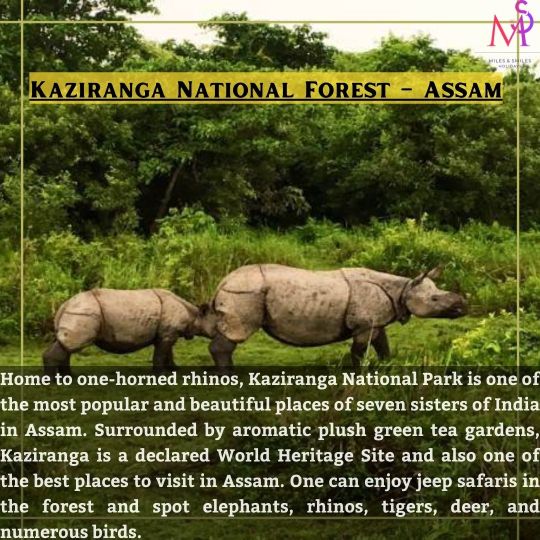
Location: Kaziranga National Park, Kanchanjuri, Assam 784177 Best Time To Visit: November to April Average Temperature: 15°C How To Reach: One can take a cab or taxi from the nearest airport which is in Guwahati. Places To Stay: Summit Green Village Resort and Spa, Kaziranga Things To Do: Bird watching, touring the national park
2. Kohima – Nagaland

Best Time To Visit: October to May Average Temperature: 30°C How To Reach: The nearest Domestic Airport is Dimapur Airport from Kohima. Places To Stay: Niraamaya resorts Things To Do: Visit the war cemetery
3. Tawang – Arunachal Pradesh

Best Time To Visit: March to October Average Temperature: 15°C How To Reach: Best way to reach Tawang is by taking a cab Places To Stay: Hotel Tawang Heights Things To Do: Adventure touring
4. Imphal – Manipur
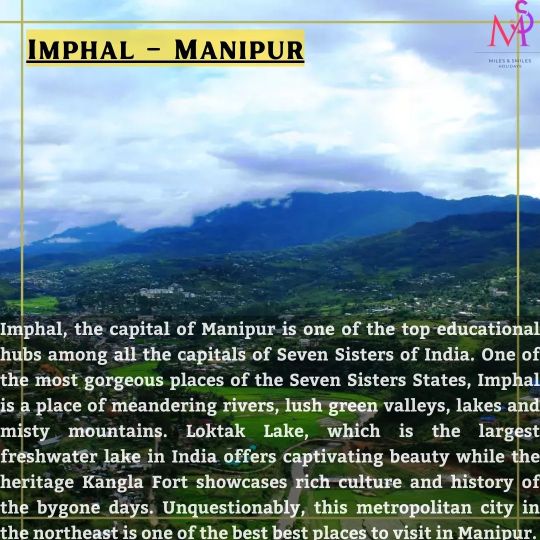
Best Time To Visit: September to April Average Temperature: Varies with the season How To Reach: The best way to reach here is by an airplane. Airport is only 8 kilometers away. Places To Stay: Manipur House Things To Do: Kangla fort visit
5. Champhai – Mizoram

Best Time To Visit: November to March Average Temperature: 20°C How To Reach: It is best to take a cab from Aizwal Airport. Places To Stay: Blueberry Inn
Things To Do: Visit Umiam lake
6. Agartala – Tripura
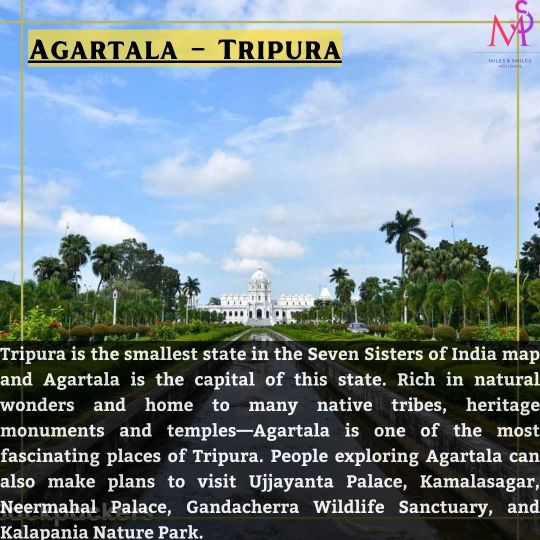
Best Time To Visit: December to March Average Temperature: 15°C How To Reach: The best way to reach Agartala is by railway. There is a railway station just a few kilometers to the south from the center of the city. Places To Stay: Hotel Polo Towers Agartala, Ginger Agartala Things To Do: Visit Ujjayanta Palace, Neermahal Palace, Heritage Park
7. Shillong – Meghalaya
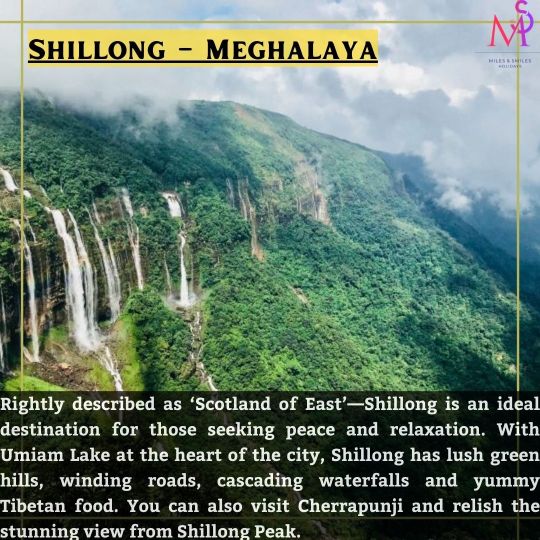
Best Time To Visit: April to June Average Temperature: 20°C How To Reach: One can take a cab/taxi from Umroi Airport which is 25 kilometers away. Places To Stay: The Loft- Executive Inn, Hotel Polo Towers Shillong Things To Do: Visit Elephant Falls, Shillong Peak & View Point, Laitlum Canyons
0 notes
Text
Top Places To Visit In Arunachal Pradesh Ensuring The Most Awesome 2022 Vacation

Arunachal Pradesh is situated in the northeastern part of India and is bordered by the states of Assam and Nagaland to the south, and by Myanmar to the east. There are many amazing places to visit in Arunachal Pradesh. And, the best time to visit these places is between the months of October and March. This is the time when the weather is at its best, and the landscapes are at their most beautiful.
0 notes
Text
Best Indian Tourist Places to visit in Summers
Summers in India are unbearable, especially in North India. But that doesn't mean you can't escape the hot weather. India has the best tourist places to make your summer a little cool and pleasant. From hill stations to beaches and more. Let's explore:
1.Andaman and Nicobar Islands: Andaman and Nicobar Islands, situated 1,400 km away from the east coast of India, are a paradise with turquoise water and history. There is a major airport and seaport in Port Blair, the capital of this union territory, offering direct connections with many tourist islands throughout the country and the world. It's a perfect destination to beat the summer heat. The most popular tourist places are Havelock and Neil islands which offer excellent diving options.

Places to visit: Radhanagar Beach, Cellular Jail, Ross Island, Elephant Beach, North Bay Island, Night Kayaking in Andaman
Best Time to Visit: October to June
2.Nainital: Nainital, nestled among the Kumaon Mountains, is one of the most beautiful hill stations in Uttarakhand. It is built around a lake whose shape is unique - hence its name, 'Naini Lake'. With snowcapped hills and serene azure lakes, Nainital has a charm that'll spellbind you. As Nainital is located at an altitude of 1938 km, it has a pleasant climate for most of the year and can be rightly anointed a picturesque idyll for tourists. Plan your summer vacation to this mesmerizing Indian tourist destination.

Places to visit: Naini Lake, Snow View Point, Mall Road Nainital, Tiffin Top, Eco Cave Gardens, High Altitude Zoo
Best Time to Visit: Throughout the year
3.Srinagar: How can we miss Srinagar when talking about beating the summer heat. With a reputation for being paradise on earth, Srinagar is every bit as beautiful as it appears to be. Srinagar, the capital of Jammu and Kashmir, is the most picturesque city in the world, lying on the banks of the Jhelum river with a cool, pleasant climate all year round. Beautiful and scenic views of the city with a perpetual influx of tourists will leave you mesmerized, engulfing you in its heavenly beauty.

Places to Visit: Dal Lake, Indira Gandhi Memorial Tulip Garden, Tulip Festival in Srinagar, Shalimar Bagh, Badamwari Garden, Char Chinar
Best Time to Visit: April to October
4.Kohima: The capital city of Nagaland, Kohima is a natural paradise. British gave the anglicized name Kohima while the original name was 'Kewhira' derived from a regional flower 'Kewhi.' This hilly tourist destination is situated at an altitude of 1500 meters above sea level and nestled with lush greenery forests, scenic landscape, and pleasant weather. All adventure enthusiasts should go there because it is ideal for trekking, camping, and hiking.

Places to Visit: Dzukou Valley and Japfu Peak, Kohima Museum, Touphema Village, Kohima Zoo, Khonoma Village, Shilloi Lake, Kohima
Best time to visit: October to June
5.Mount Abu: With its lush green surroundings and pleasant atmosphere, Mount Abu is one of the most popular tourist spots and the only hill station in Rajasthan. Nonetheless, the major attraction in the area is undoubtedly the Dilwara temple, which boasts some of the most astonishing architectural features in the country. If you're a history fanatic and want to escape the summer heat, Mount Abu is the perfect tourist place to visit.
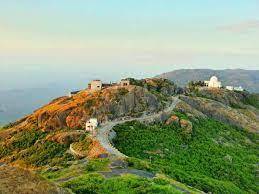
Places to Visit: Nakki Lake, Guru Shikhar, Toad Rock, Mount Abu Wildlife Sanctuary, Dilwara Temples, Mount Abu Sunset Point
Best Time to Visit: Throughout the year
0 notes
Photo

Dzukou Valley, Manipur (North East) Best time to visit: October to June The land of lush green forest, crystal clear water, colorful flowers and a visual treat to your soul- the land of flowers, Dzukou Valley is an undisturbed low land and a secret kingdom of the North East, India. Dzukou Valley is located at the border of the Indian states of Nagaland and Manipur, due to its heavenly and divine place the flora and fauna is pure and untouched. The picture-perfect Dzukou Valley is located at an altitude of more than 2000 meters and it is surrounded by the mighty Japfu hilly ranges making it an ideal holiday place for trekking. The main plant found in the valley is the tough bamboo brush and an area full of it looks like a neatly mown lawn from far away. Its alluring beauty and lavish nature is covered with countless seasonal flowers that bloom every summer. The Valley is surrounded by two icy cold rivers – Dzukou and Japhu that flows crossing each other’s path with small handmade bridge to cross the narrow rivers in the valley; it is the land of the lost where everything is like an antidote for imaginary friends. For More details of the trip, Click for Whatsapp https://bit.ly/3a6Boyn and for more packages on North East Click http://bit.ly/325r6dy Booking is on First come first book basis. T & C Applied Photo Credit @northeastmagazine @momo_irengbam . For Featuring your photo or video tag us @mytriptoindiadelhi . . . . . . . . . . . . . . . . . . . . #SelaPass #mytriptoindia #adventure #guwahati #dawkiriver #shillong #cherapunji #Mawsynram #boating #Mawlynnong #Livingrootbridge #MawjymbuinCave #Mawlyngbnavillage #Nohkalikaiwaterfall #sohra #nameri #bhalukpong #Dirang #tawang #bumlapass #chinaborder #sangtivalley #northeasttrip #loktaklake #Ukhrul #Chandel #Tamenglong #Churachandpur #Kakching #DzukouValley (at Dzukou Valley) https://www.instagram.com/p/CDRhpP0nwtb/?igshid=1rp20wwwydq1z
#selapass#mytriptoindia#adventure#guwahati#dawkiriver#shillong#cherapunji#mawsynram#boating#mawlynnong#livingrootbridge#mawjymbuincave#mawlyngbnavillage#nohkalikaiwaterfall#sohra#nameri#bhalukpong#dirang#tawang#bumlapass#chinaborder#sangtivalley#northeasttrip#loktaklake#ukhrul#chandel#tamenglong#churachandpur#kakching#dzukouvalley
0 notes
Link
Top Attractions in India Geographically India stretches from the tropical lushness of the Indian Ocean coasts to the high Himalaya, with virtually every conceivable terrain between. Combine this with a history dating back thousands of years and the result is a land of incredible diversity and endless fascination. A rich melting pot of religions and languages, regional cultural and culinary traditions and festivals, splendid artistic and architectural styles. Climate- India has such a wide range of climatic factors that it’s impossible to pin down the best time to visit weather-wise with any certainty. Broadly speaking October to March tend to be the most pleasant months over much of the country. In the far south, the monsoon weather pattern tends to make January to September more pleasant, while Sikkim and the areas of northeastern India tend to be more palatable between March and August, and Kashmir and the mountainous regions of Himachal Pradesh are at their most accessible between May and September. The deserts of Rajasthan and the northwestern Indian Himalayan region are at their best during the monsoon. India is a land of festivals and fairs. Every day of the year there is a festival celebrated in some part of the country. Some festivals welcome the seasons of the year, the harvest, the rains, or the full moon. Others celebrate religious occasions, the birthdays of divine beings, saints, and gurus (revered teachers), or the advent of the New Year. A number of these festivals are common to most parts of India. However, they may be called by different names in various parts of the country or may be celebrated in a different fashion. Religion- religion seeps into every facet of Indian life. Despite being a secular democracy, India is one of the few countries in which the social and religious structures that define the nation’s identity remain intact, and have continued to do so for at least 4000 years despite invasions, persecution, European colonialism and political upheaval. Change is inevitably taking place as modern technology reaches further and further into the fabric of society but essentially rural India remains much the same as it has for thousands of years. So resilient are its social and religious institutions that it has absorbed, ignored or thrown off all attempts to radically change or destroy them. Hinduism- India’s major religion, Hinduism, is practiced by approximately 81% of the population. In terms of the number of adherents, it’s the largest religion in Asia and one of the world’s oldest extant faiths. Hinduism has a vast pantheon of gods, a number of holy books and postulates that everyone goes through a series of births or reincarnations that eventually lead to spiritual salvation. With each birth, you can move closer to or further from eventual enlightenment; the deciding factor is your karma. The Hindu religion has three basic practices. They are puja or worship, the cremation of the dead, and the rules and regulations of the caste system. Hinduism is not a proselytizing religion since you cannot be converted: you’re either born a Hindu or you’re not. Significant differences exist within this Hindu majority, arising not only out of divisions of caste, but also out of differing religious beliefs. One great divide is between devotees of the god Vishnu and devotees of the god Shiva. There are also Hindus who are members of reform movements that began in the 19th century. The most significant of these is perhaps the Arya Samaj, which rejects divisions of caste and idol worship. Hindus may come together also as devotees of a guru, such as Sai Baba. Despite its differences, the Hindu community shares many things in common. Islam- there are more than 100 million Muslims in India (approximately 12% of the population), making it one of the largest Muslim nations on earth. Muslims are a more urban community than Hindus. There are many towns and cities in northern India where Muslims are one-third or more of the population. In addition to Jammu and Kashmir and the Lakshadweep islands, where more than two-thirds of the population is Muslim, major concentrations of Muslims live in Assam, West Bengal, Uttar Pradesh, and Kerala states. About one-quarter of all Muslims living in India live in the state of Uttar Pradesh. Muslim influence in India is particularly strong in the fields of architecture, art and food. Buddhism- Buddhism was founded in northern India in about 500 BC, spread rapidly when emperor Ashoka embraced it but was gradually reabsorbed into Hinduism. Today Hindus regard the Buddha as another incarnation of the Hindu god Vishnu. There are now only 6.6 million Buddhists in India, but important Buddhist sites in northern India, such as Bodhgaya, Sarnath (near Varanasi) and Kushinagar (near Gorakhpur) remain important sites of pilgrimage. Jain- The Jain religion also began life as an attempt to reform Brahmin cal Hinduism. It emerged at the same time as Buddhism, and for many of the same reasons. The Jains now number only about 4.5 million and are found predominantly in the west and southwest of India. The religion has never found adherents outside India. Jains believe that the universe is infinite and was not created by a deity. They also believe in reincarnation and eventual spiritual salvation by following the path of the Jain prophets. Sikhs- The Sikhs in India number 18 million and are predominantly located in the Punjab. The religion was originally intended to bring together the best of Hinduism and Islam. Its basic tenets are similar to those of Hinduism with the important modification that the Sikhs are opposed to caste distinctions. The holiest shrine of the Sikh religion is the Golden Temple in Amritsar. Other- approximately 3% of the population is Christian and there are also a few small Jewish communities in ex-colonial enclaves. India’s population is rich with diverse ethnic and cultural groups. Ethnic groups are those based on a sense of common ancestry, while cultural groups can be either made up of people of different ethnic origins who share a common language, or of ethnic groups with some customs and beliefs in common, such as castes of a particular locality. The diverse ethnic and cultural origins of the people of India are shared by the other peoples of the Indian subcontinent, including the inhabitants of Pakistan, Bangladesh, Nepal, Bhutan, and Sri Lanka. People of India – The overwhelming majority of India’s population shares essentially the same physical characteristics. There is no concrete scientific evidence of racial differences within this majority, although there are ethnic and cultural differences, such as language and religion. Tribal Groups. There are also groups of people in India that have been identified by the government as tribal, meaning they belong to one of the more than 300 officially designated “scheduled tribes”. The tribal people are sometimes called hill tribes or adivasis (“original inhabitants”), and in 1991 made up about 8% (more than 65 million people) of India’s population. Members of India’s various hill tribes are thought to be indigenous and tend to be ethnically distinct. These groups typically marry within their community and often live in large, adjoining areas, which are preserved by government policies restricting the sale of land to tribe members. Major tribes include the Gond and the Bhil. Each has millions of members and encompasses a number of sub tribes. Most other tribes are much smaller, with tens of thousands of members. Very few tribal communities now support themselves with traditional methods of hunting and gathering or with shifting cultivation because of government restrictions aimed at protecting the environment. Instead, they generally practice settled agriculture. Tribal groups tend to live in rural areas, mainly in hilly and less fertile regions of the country. Less than 5 percent practice traditional tribal religious beliefs and customs exclusively, most now combine traditional religions and customs with Hinduism or Christianity. Most tribal groups live in a belt of communities that stretches from eastern Gujarât to western West Bengal. The western tribes speak a dialect of Hindi, the central tribes use a form of the Dravidian language, and the eastern tribes speak Austro-Asiatic languages. The other major concentration of tribal people is in the northeastern hills. Tribe members make up the majority of the population in the states of Mizoram, Nagaland, Meghalaya, and Arunâchal Pradesh. These people, many of them Christian, speak languages of the Sino-Tibetan family which are also spoken by the Buddhists who live along the Himalayan ridge, from Arunâchal Pradesh in the east, through Sikkim, northern Uttar Pradesh, and Ladakh (in Jammu and Kashmîr state). In the Himalaya particularly, isolation on the mountain flanks has led to languages so distinct that ethnic groups living within sight of each other may not understand each other. Other tribes live in southern India and on India’s island territories, but their numbers are not large. Caste – The caste system is pervasive in India. Although it is entwined in Hindu beliefs, it encompasses non-Hindus as well. A caste (jati in Sanskrit) is a social class to which a person belongs at birth and which is ranked against other castes, typically on a continuum of perceived purity and pollution. People generally marry within their own caste. In rural areas, caste may also govern where people live or what occupations they engage in. The particular features of the caste system vary considerably from community to community and across regions. Small geographical areas have their own group-specific caste hierarchies. There are thus thousands of castes in India. In traditional Hindu law texts, all castes are loosely grouped into four varnas, or classes. In order of hierarchy, these varnas are: the Brahmans (priests and scholars), the Kshatriyas (warriors and rulers), the Vaisyas (merchants, farmers, and traders), and the Sudras (laborers, including artisans, servants, and serfs). The varnas no longer strictly correspond to traditional professions. For example, most Brahmans today are not priests, but professionals in a variety of industries. Dusshera- Dusshera is usually celebrated in October. The mode and the fervor vary by a great deal across the subcontinent; the celebration in Mysore is one of the most famous. Different parts of India celebrate the festival in different ways. Some celebrate it as Navaratri, some as Vijaya-Dashami, and some as Dussehra, in worship of Goddess Durga or celebrating Rama’s victory over Rawana. The celebrations vary from a day to nine days (for Navaratri) to a month (for Mysore Dusshera). On the day of the Holi, people (men and women) irrespective of caste and creed mingle together and exchange colors. The celebrations can get wild and rowdy – it is one of the few occasions of the year that the sexes are allowed to mix freely. People use tools and tricks to spray, paint and drown friends and relatives in color Pongal or Sankranti- This holy day marks the commencement of the Sun’s northern course in the Heavens, known as the Uttaraayana patha. Interestingly, this is the only festival in Hindu calendar that follows a solar calendar and is celebrated on the fourteenth of January every year (all other Hindu festivals are computed using the lunar calendar). Pushkar Camel Fair- Back in a legendary time, Lord Brahma was flying over the Rajasthan desert on his swan, when some petals fell from his hand and drifted down. Miraculously, blue lakes sprang up where the flowers touched the soft sands. Lord Brahma realized that this was the auspicious moment to perform a fire sacrifice so he landed near one of the lakes, completed the powerful ritual and, thus, laid the groundwork for the first Pushkar Fair. Ever since then, when the full moon shines on Purnima during the autumn period of kartik, the desert tribes meet to commemorate this epic event.
0 notes
Text
6 Mesmerizing Places to Explore With North East Tour Packages in 2020
North East comprises of the Seven sister states Assam, Arunachal Pradesh, Nagaland, Manipur, Mizoram, and Tripura along with Sikkim and boasts of alluring natural beauty and rich biodiversity. Its diverse landscape and enchanting beauty of the rolling hills, aromatic tea gardens, serene lakes, and picturesque landscape attracts visitors from far and wide places. If you wish to experience all this and more with your Northeast tour packages, make sure to check out these awesome places.
Top 6 Places Places to Visit in the North East in 2020
Some of the best places to explore in the much-famed Northeast as a part of your Northeast tour packages are as follows:
Kaziranga National Park:
The Kaziranga National Park is listed among the UNESCO World Heritage sites and is home to more than 35 species of mammals and a wide variety of migratory birds that fly down in here each year. The start attraction of this park is the rare one-horned rhinoceros which is found in only very few places in the world.
Location: Kanchanjuri, Assam
Best time to visit: November, February, and April
Famous for: The one-horned rhinoceros.
Goecha La
Located at an altitude of 4,940 m above sea level, its the base camp for the third highest peak in the world Mt. Kanchenjunga. A heaven for adventure seekers, Goecha La is a great place for trekking in the mids of the breathtaking vistas of the snow-capped mountains and peaking glaciers.
Location: Sikkim, India
Famous for: Sightseeing, base camp for trekking
Best time to visit: March & April
Nuranang Falls
Also known by the name of “Bong Bong Falls”, this 100m high waterfall is an epitome of serenity and the lush greenery set as a backdrop the milky waters of the falls gives a feeling of serendipity especially for couples who love to frequent this place quite often.
Location: Cona, Shannan, Arunachal Pradesh
Best time to visit: February to November
Activities to try here: sightseeing, swimming
Dawki
Dawki is the only river in India that is known for its waters which is so clear that it seems transparent. People come from far and wide places to enjoy boating in this river where you can clearly see the river bed.
Location: West Jaintia Hills district, Meghalaya
Famous For: Umngot River and Dawki Bridge
Best time to visit: November
Nagula Lake
Nagula Lake is one of the many hidden treasures that Arunachal Pradesh beholds. Hidden in the midst of the snowy mountains and located at an altitude of 4,300 ft. this beautiful lake charms its visitors with its serenity and picturesque charm.
Location: Tawang, Arunachal Pradesh
Best time to visit: September to October is the best time when the lake poses serene and peaceful views. April to May is also a great time and you might have a chance to see snow.
Famous for: Picnic and sightseeing
Nongriat Village
A village known for its multi-level root bridges is one of the most popular tourist attractions in the North East. Located in one of the rainiest places in the world, the Nongriat Village features a number of natural “root bridges” entwined with some man-made structures that leave all its visitors amazed.
Location: Nongriat Village, Cherrapunjee
Best time to visit: All throughout the year except monsoon
Famous for: Double-decker living roots bridge
This amazing list of amazing places to visit in the North East is sure to have awakened the travel bug in you. If that’s the case then why delay, book your North East tour packages now and hit the road exploring some of the most popular;ar attractions along with a couple of offbeat attractions that will leave you nothing but amazed.
0 notes
Text
The Fascinating Seven Sisters of India
Fondly referred to as the “Seven Sisters of India” the seven different North-Eastern states are tourist attractions. Visiting the Seven Sisters states provides a very different experience than one usually gets while traveling the Indian mainland.
‘Seven Sisters of India’ are known for their different exotic and culture. These Seven Sister’s states attract young travelers and explorers from all over the world. They have different tribal and ethnic groups, religions, festivals, and fabulous landscapes. It is home to some of the best scenic and breathtaking views in the world. One can enjoy the trekking routes, wildlife tours, and river expedition.
Beautiful Seven Sisters of India States
Here given below is some information on each of the Seven Sisters of India.
Seven Sisters of India State ASSAM:
Assam is also known as Ahom. Assam is unveiling the hidden charm of the North-East. The place is a gift-wrapped with rolling fields of aromatic tea, canoes sailing down the Brahmaputra river, thick jungles with bizarre wildlife.
Tourist Attractions: attend the Bihu festival that marks the change of season, Ambubachi Mela in June dedicated to Goddess Kamakhya. Explore wildlife spotting in Kaziranga National Park, and Joy cruising on the Brahmaputra River.
Places to visit in Assam: Kaziranga National Park, Majuli Island, Manas National Park, Kamakhya Temple, kakochang Waterfalls, Hoollongaper Gibbon Wildlife Sanctuary, Tocklai Tea Research center, Nameri National Park, Padam Pukhuri, Haflong Lake and Hill, Panimoor Falls.
Food: relish the authentic Assamese Tea in a Tea estate, an aquatic dish prepared in sour curry, Khaar a meat delicacy, Duck meat Curry, and Aloo Pitika, etc.
Best time to visit: all year round
Seven Sisters of India State MEGHALAYA:
Meghalaya means “abode of clouds”. It’s famous for being the wettest place on earth. Meghalaya remains one of the rare locations that can be visited all year round and compensates every traveler’s thirst for a fulfilling retreat. It‘s best to admire the dramatic cliffs, lofty waterfalls and the endless caves of the place during the rest of the year.
Tourist Attractions: visit the Double Decker living root bridges, Mawlynnong village, Dawki Shnongpdeng, Krang Suri Falls, Ka Khoh Ramhah, Nohsngithiang Falls, and Shilling Peak, etc.
Places to visit: the gems namely Cherrapunji and Shillong make the state truly a wonderland
Food: Jodoh, Nakham Bitchi, Dogkhlieh, Bamboo Shoots, Pumaloi, and Momo
Best time to visit: October to April
MANIPUR
It is a spectacular off-beat tourist destination in India. The land is popularly referred to as the “Switzerland of India” with breathtaking blue hills. The state was given the name as “The Jewel of India” by late Jawaharlal Nehru. Manipur, the pride of North-East India is ever blooming as a tourist destination. To learn the place deeper, you must spend quality time interacting with the locals.
Tourist Attraction: Loktak Lake, home to the only floating park in the world, Tharon cave, Singda Dam, and Manipur Zoological Garden.
Places to visit: Imphal, Thoubal, Tamenglong, and Ukhrul
The Cuisine of Manipur: Chamthong or Kangshoi a vegetable stew, Eromba a combination of vegetables and fish, Morok Metpa spicy chutney, Singju a salad, Paaknam, Chak-hao Kheer a popular dessert and Nga Thongba a classic fish curry.
Best time to visit Manipur: October to April
Seven Sisters of India State ARUNACHAL PRADESH:
The meaning of Arunachal Pradesh is a “Land of the dawn-Lit Mountains”.
Arunachal Pradesh is rich with picturesque beauty offering relaxation and rejuvenation. The place offers you peace and action. This wonderful getaway is home to the valley, gushing waterfalls, crystal clear lakes, and picturesque mountain top. It is the largest among the other North-Eastern States in India. If you are an energetic adventurist or a spiritual enthusiast you will have a host of options to choose from on your magical journey to Arunachal Pradesh. Popular sports include trekking, hiking, camping, and rock climbing.
Tourist attractions: ancient temples, historical monuments, monasteries, waterfalls, museums, and sanctuaries
Places to visit: Tawang, Roing, Itanagar, Bomdila, Ziro, Bhalukpong, Pasighat, Namdapha National park, Sela pass
Cuisines: rice, fish, bamboo shoots, meat, and green vegetables
Best time to visit: summer (April to June)
NAGALAND:
The hilly region in the North-East of India makes an amazing tourist destination. The serene atmosphere makes you unwind and relax. The exquisite landscape and beautiful sunrise elevate your spirits to a different plane. It is a perfect place for adventurous activities like trekking, jungle camping, and rock climbing.
youtube
Attractions: witness the colorful Naga Cultures at the Hornbill Festival, trek to the Dzoukou Valley, Hike the Japfu Peak, mountain biking, shopping in Naga bazaar, Kohima, and visit the Triple Falls. Places to visit: Kohima, Dimapur, Mokochung, Wokha, Mon, Phek, and Kiphire
Cuisine: Ingredients: Bamboo Shoot, Axone (fermented soya bean), Anishi (Dry colocasia), and fermented Dry Fish
Dishes: Samathu, Aikibeye, Akini, Chokibo, boiled vegetables, Bush Meat/Dog meat, Zutho (rice Beer)
Best time to visit: summer March-May, winter October- March
Seven Sisters of India State TRIPURA:
This state lies in the cozy lap of the Himalayas. It is a wonderland of natural beauty with its deep valleys, running streams, and rivers. It is a dream destination for nature lovers. Forest, breathtaking valleys, gorgeous waterfalls, and majestic mountains make Tripura a perfect place to unwind.
Attractions: boating to the Neer-Mahal, pilgrimage to Jagannath and kali Temple, Stroll through the Heritage Park, visit the glorious Ujjayanta Palace, and explore Unakoti.
Places to visit: Agartala, Dharmanagar, Udaipur, and Ambassa
Cuisine: Chauk (rice Beer), Berma (fermented and dried fish) Gudok (stuffed bamboo pipes), wahan (Pork item)
Best time to visit: October to May, but try to avoid the rainy season.
Seven Sisters of India Mizoram:
The name Mizoram in local language is “The Land of the hill people”. The beauty of North-East India is unique and one has to visit this part of the country at least once in their lifetime. Mizoram is a dazzling treasure trove for the discerning travelers for its amazing array of cultures, festivals, dances, handicrafts, and rich flora and fauna. Mizoram is blessed with a splendid paradise that will leave you mesmerized with its natural beauty.
Best place to visit: Aizawl, Champhai, Lunglei, Serchhip, and Lawngtlai
Attraction: Vantawang Falls, mountain biking in Hmuifang Hill, trekking in the Virgin forests, caving in Khuangchera Puk, Dampa Tiger Reserve, and Mizoram state Museum
Best time to visit: November to March
Cuisine: Bamboo shoot fry, bai, chhum Han, Mizo Vawksa, paanch Phoron Torkari, Misa Mach Poora, and Koat Pitha
Let’s feel the warmth of Mother Nature and sway into the lap of a blissful paradise with these Seven Sisters of India State tours.
from The Traveller https://ift.tt/2GXREVq via IFTTT
from WordPress https://ift.tt/384lF1S
0 notes
Text
Get the best idea to visit Assam Wildlife Sanctuary
Are you looking for the best Assam Wildlife Sanctuary to make your vacation more meaningful and stunning, if you really want it then get the best idea to visit Assam Wildlife Sanctuary with best coast and comfort accommodation?
Assam wildlife sanctuary is known as a mixture of a variety of flora and fauna. The state also consists of biodiversity zones in the world, the tropical rain forests, deciduous forests, riverine grasslands, bamboo orchards, and numerous wetland ecosystems had made Assam as a Paradise.
Wildlife Sanctuary is one of the protected areas where the animals are kept reserved for the conversion of only animals and human activities like harvesting of timber, collecting minor forest products and private ownership rights are allowed as long as they do not harm any animals.
Some about Assam
The more you know about Assam more you love to visit, located in the south of the eastern Himalayas along with the Brahmaputra River Valley, Assam is one of the beautiful and most visited places of North East India.
Assam shares international borders with Bhutan and Bangladesh the state comprises of a host of explored unexplored sanctuaries and national parks.
Assam became a part of British India after the British occupied the region following the First Anglo-Burmese War of 1824–1826. Assam is well known among the many wildlife holiday destinations in North East India.
A state is covered with the seven sisters like Arunachal Pradesh, Nagaland, Manipur, Mizoram, Tripura, and Meghalaya. The state comprises of a host of explored unexplored sanctuaries and national parks.
Assam is renowned for its lush green tea garden and another is for One Horned Rhinoceros, to explore all these lots of people from all the corners loves to visit Assam.
The state has its own natural beauty that you a chance to explore the stunning and marvelous historical places, along with the tourist places Assam also gives a chance to delve into the rich culture and the colorful festivals makes your tour more interesting and mesmerising. Its boosting tradition, culture, arts crafts has made Assam unique places for visitors.
Why Assam is called home for the wildlife sanctuaries
Assam is called home to several wildlife sanctuaries and national parks because among the other state or country Assam is only the state that had protected varieties of animals that are not found in another state.
Where the tourists have the most thrilling experience encountering wonderful creatures in their natural habitat. The many wildlife sanctuaries in Assam provide shelter to of wildlife, right from the Golden Langur, Bengal Tiger to the one-horned rhinoceros.
How much wildlife Sanctuary is there in Assam
There are mainly 18 Wildlife Sanctuary and 5 National Park in Assam, other than Kaziranga National Park, Manas National Park are declared as one of the UNESCO World heritage sites.
Now let’s move towards some of the National Park and the Wildlife Sanctuaries of Assam.
Kaziranga National Park
Kaziranga National Park is located in Golaghat and Nagaon districts of Assam, covering an area of about 430 sq Km along the river Brahmaputra on the North and the Karbi Anglong hills on the south, these park is one of the oldest parks in Assam
Kaziranga National Park, a World Heritage Site and a Tiger Project are famous for the Great Indian one-horned rhinoceros. Other residents of the park include elephants, Indian bison, four species of deer, tiger, leopard, capped langur, wild boar, hoolock gibbon, etc and a host of resident and migratory birds.
Amongst the birds, the crested serpent eagle is common while palla’s fishing eagle and gray-headed finishing eagle are frequently seen. Others include the Great Adjutant Stork, crane, Bengal florican, bar-headed goose, whistling teal, and pelican.
Distance from Guwahati to Kaziranga is about 5 hours journey by car. The park is open from November to April.
Manas National park
Manas National Park is UNESCO Natural World Heritage site, a Project Tiger Reserve, an Elephant Reserve and a Biosphere Reserve in Assam, India. Located in the Himalayan foothills, it is contiguous with the Royal Manas National park in Bhutan.
The park is known for its rare and endangered endemic wildlife such as the Assam Roofed Turtle, Hispid Hare, Golden Langur, and Pygmy Hog. Its core area is 500 Sq Km and records 60 species of mammals, 350 species of birds and its diversity of habitat is very high.
The time that takes from Guwahati to Barpeta by road is a maximum of 5 hours and from Barpeta road to Mathanguri camp, takes a maximum of 1 hour. October and May are the best time to visit Manas National Park.
Dibru- Saikhowa National Park
The distance from Tinsukia town is 10 km and from nearest Dibrugarh airport is 54 km. From Guwahati, the distance is 510 km, 12 hours by road. Dibru-Saikhowa is one of the biodiversity hotspots situated in the south bank of the river Brahmaputra in the extreme East of Assam state in India. Dibru-Saikhowa, which has an area of 340 sq km, is among the most vibrant wildness on earth and is also distinct for her pristine scenic beauty. Situated in the flood plain of Brahmaputra, Dibru-saikhowa is a safe haven for many extremely rare and endangered species of Wildlife
The forest type of Dibru-Saikhowa comprises of semi-evergreen forests, deciduous forests, littoral and swamp forests and patches of wet evergreen forests. Famed for Feral horses, a total 36 species of mammals and above 400 species of birds have so far been recorded from the Dibru-Saikhowa National Park. Tourist can visit these places in the month of April and October.
Namdapha National Park
Namdapha National Park is one of the avifaunal most diverse areas in the World. The wide altitudinal range (200 to 4571 m MSL) supports a huge diversity of habitats.
Over 500 species of birds are recorded here including a large number of rare, endemic and restricted-range species of global conservation importance. It is also one of the few Indian Protected areas with five species of Hornbills. The best time to visit Namdapha National Park is in March to November.
Nameri National Park
Nameri National Park is located in the sonitpur district of Assam. Nameri shares its northern boundary with the Pakhui Wildlife Sanctuary of Arunachal. Its area is 203 sq km.
This is an excellent elephant country and ideal habitat for a host of other animals including the tiger. It is also home to the Leopard, Bison, Sambar, dhole (the Asiatic wild dog), Hog Deer, Muntjac, Wild Boar, Sloth Bear, Himalayan Black Bear, Capped Langur, Indian Giant Squirrel, etc.
Nameri is a bird paradise with over 300 species of birds – including the white-winged wood duck, four distinct species of Hornbill, Blue-bearded Bee-eaters, Babblers, Plovers and more.
A tour without exploring the above park will be incomplete, so do not miss these opportunities.
Wildlife sanctuaries where you can delve into are like
Hoollongapar Gibbon wildlife Sanctuary
Hoollongapar Gibbon wildlife Sanctuary is an isolated region of Assam, and one of the best places that attract tourism, this located is surrounded by tea gardens and long stretches of grasslands.
This wildlife sanctuary consists of rich biodiversity, here you can find the hoolock gibbons, and Bengal Slow Loris, Northeastern India's only nocturnal monkey.
Bura-Chapori Wildlife Sanctuary
Bura-Chapori Wildlife Sanctuary situated in the wonderful place of Assam, covering the moderate expanse of 44.06 sq km in Sonitpur district.
East Karbi Anglong Wildlife Sanctuary
East Karbi Anglong Wildlife Sanctuary has an exotic flora as well as rare species of wild animals and birds. The reserve is used to protect and preserve variegated species of resident and migratory birds.
Laokhowa Wildlife Sanctuary
Assam a state is itself gifted with a wide range of flora and fauna. There are numerous wildlife sanctuaries in Assam. this sanctuary is located 25 km from the Nagaon District of Assam, Laokhowa is one of the best wildlife Sanctuary which is also called as a home to the innumerable home for the bird’s species and animals.
Other wildlife sanctuaries that you can explore in Assam are like
Garampani wildlife Sanctuary, Burhachapar wildlife Sanctuary, Pobitara wildlife sanctuary and more.
So, get the best idea to visit Assam wildlife sanctuary and make your next tour more interesting and amazing.
And if you want to know more information to book your tour packages then comment us in the below-given box, or if you want to know the coast of these packages then you can feel free to mail us in the below-given mail address
0 notes
Text
Northeast India’s Most Scenic Villages
North-East is one of the most unexplored areas in India. When you visit the spot you'll be pleased to state that it's in India. It's a little world loaded with astonishments on the off chance that you are prepared to explore.The stunning perspectives on mountains, the interminable verdant, the mysterious cascades, the wild gives in and the particular culture of North-East India will leave you with an astounding travel experience.You will slobber over the North-eastern cooking styles as these have a great deal of assortment and are unique in relation to the remainder of India.
North-East India has everything for you. And so on and you get the opportunity to investigate your sort of spot. I needed to encounter the wild of the Natural caverns. The caverns are the home to numerous bats and various types of creepy crawlies. Regardless of being terrified of bugs I set out to investigate the dull caverns and it was probably the most out of control understanding of my life. Minor cascades coursing through the lime-stones and the ceaseless haziness with bats all around made for one of the most vital days of my excursion!
The lovely towns of North-East will blow your mind. Some of them have intriguing certainties about them with the magnificence. How about we investigate the Scenic Villages of North-East India.
Ziro Valley, Arunachal Pradesh
The least known spot in North-East India, Ziro Valley has charming atmosphere consistently, so you rucksack to this spot any day you need. It is only 115 kms from the state capital Itanagar and will take you around 4 hours to reach. Ziro Valley, otherwise called Apatani Plateau is home to the Apatani Tribes. The green rice field patches make the spot look dazzling! The Taley natural life haven, Kile Pakho edge and the Bamboo forests merit a visit. On the off chance that you are arranging a unique and serene outing, at that point this is the goal for you!
Tawang, Arunachal Pradesh
Tawang has the biggest religious community in India and the second biggest on the planet. Arranged at a stature of 10,000 feet, it is a lovely unique slope town to investigate. The best time to visit Tawang is in summers from March to September. Tawang is 326 kms from Tezpur which will take around 12 hours. In winters it's everything secured with day off. With its blue and dim skies out of sight and 65 white-brilliant structures, this beautiful community should be on your rundown!
Majuli Island, Assam
The world's biggest freshwater island is in India in Assam and you can visit this heaven whenever from October to March. Be that as it may, in storms it looks the most lovely when the waterway is swollen with water. Majuli Island is shaped by Brahmaputra stream and is just available through ships from the city of Jorhat. Reasonable enough! This great spot ought to be kept escaped the remainder of the world. The regular grand excellence, the shocking scene with blue water and greenery all around, and a fowl haven – make it perhaps the best spot to travel.
Moirang-Loktak Lake, Manipur
Discussing water, I can't miss on the amazing Loktak Lake. The Largest freshwater lake in North-East India coasts in Manipur in Imphal which is effectively open from all the real towns of Manipur by transport. It is the main drifting lake on the planet in light of the Phumdi – mass of soil, vegetation and natural issues at different phases of breakdown. Phumdi is spread over the lake making it look staggering. Aside from its magnificence, Loktak Lake is likewise known for its delicious fish. Dried fish is one of the most loved nourishments in Manipur and it is found here in bounty.
Dawki, Meghalaya
The perfectly clear greenish-blue stream makes Dawki one of the most appealing spots in Meghalaya. Drive to Dawki through the tourist detour of 70 Kms from Shillong. The water is so clear and clean, it would appear as the vessel with anglers is drifting noticeable all around. Dawki is one of only a handful couple of street fringes going among India and Bangladesh. The two countries are associated with a suspension connect over the stream for normal exchanging which makes it considerably all the more entrancing! You will return invigorated and renewed. This spot will give you a dreamlike encounter.
Mawlynnog, Meghalaya
Mawlynnog town, additionally alluded to as "God's very own nursery", has won the praise of being the cleanest town in Asia. It is situated around 90 kms from Shillong. It's tranquil and quieting just to stay there in the midst of greenery with a delicate murmuring of cascade out of sight. You will be stunned to see the living root connects here. The underlying foundations of two trees on inverse sides of a waterway have interlaced, making it a characteristic extension for the town society. Go for a stroll on the extension and meet the nature taking care of business!
Dzukou Valley, Manipur
The characteristic excellence and the fascinating blossoms of Dzukou valley will blow your mind. The mysterious valley resembles a lala land. Dzukou valley is closest to Kohima, capital city of Nagaland. The emerald green slopes, the streams streaming by and the lavish green timberland are charming! Make tracks in an opposite direction from the hustle clamor of urban areas and lose all sense of direction in the tranquility and quietness of the spot. When you need to invest energy with yourself and the delighted nature, this is the ideal goal for you!
Zuluk Village, Sikkim
Zuluk Village, when a point to the notable Silk Route from Tibet to India, has stayed unaltered since that time. Gangtok and Siliguri are the closest places to reach Zuluk. Extraordinary compared to other odd goals in East Sikkim, it offers the perspective on the whole Kanchenjunga run. No words can portray the dawn over Mt. Kanchenjunga, when the sparkling beams of sun kiss the snow-clad pinnacles of mountains, washing them with brilliant and after that in the end silver! This is probably the best fascination in Zuluk.
Gather your sacks and make tracks in an opposite direction from this uproarious world to invest some energy with yourself and these normal delights!
0 notes
Text
Exploring Exotic Northeast: A Short note on wildlife of India
If you are a travel fanatic definitely you are going to enjoy any short note on wildlife of India. A short note on wildlife of India will not only gives you huge idea about the local bio diversity of a place at the same time if you are planning to visit this place in the month of February you are sure that the people are making the right choice out of it.
A land as diverse as India, it is obvious that you are bound to come across exotic wildlife, rich flora and vast expanses of green. While many have travelled and explored the country, the 8 Northeastern states remain fairly untouched. And it is these very states that boast not just beautiful landscapes but a number of wildlife sanctuaries like KeibulLamjao National Park in Manipur and the famous Kaziranga National Park in Assam. With much to explore here's a short note on wildlife of India.
Here is a list of 8 destinations across the Northeast that boast amazing wildlife in India.
1. Kanchendzonga National Park - Sikkim
This short note on wildlife of India informs you about the Himalayan range, which is a national park that covers 850 sq km and boasts dense forests of Oak, Maple, Fir, Birch and Willow. The Kanchendzonga National Park is home to more than 500 bird species that include the Himalayan griffon, Sunbird, green parrot, tragopan and pheasant. Endangered species like the Asiatic wild dog, red panda, snow leopard and Himalayan black bear inhabit this park. A striking feature about this rich biosphere is the abundance of medicinal plants and herbs found here. There are high altitude lakes at the park which are the best locations to visit in this month of February. If you are planning a visit here, the best time to do so would be the months of April and May. Before you plan your trip, make thorough research on any short note that you find on wildlife of India so that you know the place better than anyone else. It will help you to visit those locations with better efficiency.
2. Kaziranga National Park - Assam
Established in 1908, this park was declared a World Heritage Site in 1985. Spread over 430 sq feet, this national park boasts tropical forests watered by four rivers including the Brahmaputra. In this short note on wildlife of India Kaziranga National Park has also been included which is home to the one-horned rhinoceros, a major attraction here. This short note on wildlife of India also informs you about 15 different species of turtles which consider this park a home.In this place you will come across a number of Asiatic water buffaloes, swamp deer, golden jackals, sloth bears, mongoose and leopards. Reptiles that inhabit this park include the reticulated python, Russell’s viper, monitor lizard and king cobra. Bird watchers will find blabbers, hornbills, the Bengal florican, slender-billed vulture and the Indian white vulture here. To experience the best of this national park, visit it from mid-October through March.
3. Namdhapa National Park - Arunachal Pradesh
The largest national park in Northeast India, this is a paradise of flora and fauna which is home to a number of rare mammals, dhole and Himalayan black bear. During a safari here, you will come across musk deer, blabbers, palm civets, red giant flying squirrels, wild boars, gaur, goral, sambal, owls, takin and eagles. Felines like the clouded leopard, snow leopard, the common Indian leopard and tiger prowl around this national park. Apart from this, tribes such as the Chakmas, Lisu, Singpo and Tangsa inhabit the Namdhapa National Park. The best time to pay this park a visit would be from October through May.
4. Balphakram National Park - Meghalaya
This short note on wildlife of Indiaalso includes some of the best wildlife parks of the north east India which is encompassed by the Garo Hills.This national park is home to elephants, red pandas, water buffaloes, 8 species of cats, magpie-robins, red-vented bulbuls, black-breasted Kalij pheasants, black drongos, jungle mynas, the Indian great horned owl, hill mynas, spotted forktails, Burmese roller, black bulbul and the Himalayan whistling thrush. Visit the Balphakram National Park from April through June and enjoy which is a homeplace for different variety of butterflies too. Before coming here you might go through any other short note on wildlife of India too for knowing such things.
5. KeibulLamjao National Park - Bishnupur, Manipur
This park surrounds the famous Loktak Lake, the only floating lake in the world. Keibul Lamjao National Park spans 40 sq km and is located in Bishnupur district of Manipur. The famous brow-antlered deer - Sangai, the state animal of Manipur is found here. These aquatic wetlands here is inhabited by kraits, blue-crested lizards, civets, pythons, boars, rat snakes, flying foxes, skylarks, black kites, spot bill ducks, cranes and a variety of deer and cats. In this short note on wildlife of India alongside animals, reptiles and birds, tribes such as the Brel, Maril and Thang inhabit this place. The best time to visit this beautiful park would be the months of October through March.
6. Murlen National Park - Mizoram
Located near the Chin Hills, the Murlen National Park spans over 200 sq km and boasts rich flora and fauna. If you are reading this short note on wildlife of India then plan your tour trip during the months of October through March.This national park is inhabited by few rare wildlife species like Malayan giant squirrels, Hume’s pheasant,, macaque, sambar, rhesus, barking deer, partridge and black bears.
7. Ntangki National Park - Peren, Nagaland
Another treasure trove of wildlife and flora, this national park is spread over 20, 202 hectares and boasts grasslands and thick forests. If you want you might research through some of the other short note on wildlife of India where you will come to know that this place is a home to hornbills, golden langur, gibbons, civets, pythons, black storks and sloth bears, the Ntangki National Park is best visited from November to April. A number of Naga tribes inhabit this national park. Of these tribes, the Zeliangrong tribe is the dominant one here.
8. Trishna Wildlife Sanctuary - Tripura
Ever heard about Tripura? OF course you have, this short note on wildlife of India also covers that place which extends area of 163 sq km, this wildlife sanctuary is home to the Indian Gaur, hoolock gibbon, pheasant, capped langur, a number of reptiles and mammals. The Trishna Wildlife Sanctuary has been noted in some of the other short notes on wildlife of India because of its rich biodiversity. It extends 18 km from Belonia till Agartala and is connected by the state highway. The winter months are the best time to pay the Trishna Wildlife Sanctuary a visit.
Wasn't this short note on wildlife of India informative? With such details in hand, pack your bags and get ready to explore 8 exotic Northeastern locations of wildlife sanctuaries in India.
0 notes
Photo

New Post has been published on http://routebyroad.com/36236/assam-reveling-scenic-assam-resplendent-tea-gardens/
ASSAM - REVELING IN SCENIC ASSAM WITH RESPLENDENT TEA GARDENS
Bihu Festival Assam
Capital: Dispur Largest city: Guwahati
Assam is a tourist abode due to its magnificent climate and scenery and also its vast tea gardens that stretches from hillock to the next and further than your eyes can see. Assam is known as the Tea Garden of India and any visitor to this state would be able to feast their eyes in almost any areas they are in. Tea estates abound in the state and you may watch thousand upon thousands of hectares of hills planted with world famous tea plants when you are on the road, rail or air. It is of course not just tea that Assam is famous for as it has petroleum and the well known Assam silks. The state also boasts of some of the finest wild life sanctuary and has unique flora and fauna for naturalists, animal lovers and photographers. From above Assam resembles a large bird taking off for flight with its wings spread. The entire area covers 78,438 square kilometers and is surrounded by the popularly called the Seven Sister States. These are Arunachal Pradesh, Nagaland, Manipur, Mizoram, Tripura and Meghalaya.
More of Assam
Assam is also known as the land of red river and blue hills a sharp contrast here and eye catching colors there in its ambience therefore makes it a must visit for anyone landing in India from abroad. The government has always encouraged tourism which is one of the top revenue earning industry apart from the other revenue sectors like petroleum and tea.
The area is demarcated geographically as the Brahmaputra Valley which is large and very fertile and this may be recalled as the wing of the bird while the tail constitutes the Barak Valley. You will find the North Cachar Hills and the Karbi Plateau on the so called bird’s chest portion.
The biodiversity of Assam is extraordinary and being a convenient stop over for making visits to other neighboring states a very large number of tourists touch down on this place from far and wide. About 35% of the state is covered by forest and the rest by terraced tea gardens, fertile plains for crops, marshy land and hills.
Mythological and recorded history
Although Assam has a very old past civilization as proof of Stone Age relics have been found by archeologists, it has however no evidence of having crossed through the Bronze and Iron age. The recorded history has evidence in the 4th Century Allahabad Pillar where it is inscribed the presence of Kamarupa or Western Assam and Dhanuka or Central Assam. The inscription has been depicted on the Samudragupta’s Pillar which shows that ancient people have recorded the might of the Gupta Empire and the limits of its eastern borders.
Apart from recorded history mythological tales from the Kalika Purana has mentioned the land often. It states that the first ruling dynasty of Assam was Mahiranga Danav and he formed the Danav dynasty. Later on it states he was thrown out by of his throne by Naraka of the Naraka dynasty. The last ruler of the Naraka was killed by Lord Krishna and Naraka’s son Bhagadata fought for Kauravas in the battle of Kurukshetra.
Physiographical outlay
Assam has three main divisions if you were to look at it from the physiographical way. These are the Northern Himalayas or Eastern Hills, the Northern Plains or Brahmaputra Plains as they are called here and the Deccan Plateau which in the local language is called Karbi Anglong.
Grand tourist sights for holidaying
Assam by virtue of its sceneries and friendly people has become a great tourist attraction and has therefore enticed people from all over India and abroad to take a few days holiday in one of its many resorts, hotels and outdoor camping facilities. The richness of nature abounds here and you will never see a piece of land wasted as the greenery is all pervasive here.
Assam boasts of one of the largest wild life sanctuaries in India and is the home of the famous one horn rhinoceros and other rare birds and animals. The banks of the rain fed and snow fed perennial River Brahmaputra is milder when it enters into Assam from Arunachal Pradesh and therefore better for boating, fishing, sightseeing and relaxing tours.
Guwahati is the capital of Assam and has a splendid airport both for domestic and international airlines and may even serve you as the vantage point of visiting not only the whole of Assam, but the neighboring states as well. You have good hotels and resorts to choose from at Guwahati and you may plan your whole tour of the state from here. Needless to say, the whole tour plan may take more than a week as there are enough tourist spots to last a whole month yet you may be choosy to begin with.
Guwahati offers both sightseeing and religious tourism. If you are religiously inclined then you may visit Kamakhya Temple and Umananda as first two spots and move around Guwahati and see what other religious places are possible to visit in one day. If you are not particular about religious tourism then you may visit Shankardass Kalakshetra or the Assam State Zoo, the latter may suffice as you may see the wild animals sheltered there if you are in a hurry.
Otherwise, you ought not to miss the Chandrapur and Pobitara Wildlife Sanctuary. If you are in a group or with family members then you may be able to enjoy some of the best scenes by taking a river cruise on the River Brahmaputra. You may get some good guidance from the reception counter of the hotel where you are staying as most hospitality centers in Assam are tourist oriented and friendly.
You must surely take time to visit Kaziranga National Park which is a UNESCO world heritage center and is the home to one horn rhinoceros and other wild and usually not much seen animals and birds.
If you are also interested in some mystery and a place where there is some unusual happenings then you must never fail to visit Jatinga. This is a village located at Dima Hasau which has become famous due to a series of suicide by migratory birds and that too without any particular reason during the months of September and October. They do this by smashing themselves on the tree and buildings. The strange sight has jolted everyone including the tourists and a scientific explanation is yet to be made.
You may also visit Jorhat which is called the tea capital of India and you can enjoy the beauty of the grand tea gardens stretching out into the horizon. If you love such natural scenery then you may also visit Haflong which is the only hill station in the whole of Assam.
But surely not the least in importance is Sonitpur from where you may visit Nameri National Park, Bura Chapon Wildlife Sanctuary, Sonai Rupai Wildlife Sanctuary, and Orang National Park. Just a little way from Sonitpur is Tezpur which is a small town and has unique culture and history of its own. Suppose you and your group members would like to see something quite different and perhaps keep in touch with the lifestyles of the modern day comforts then you may choose to go to Tinsukia. This place has malls and other city attractions to give you the delight of a city life. You may likewise make a visit to Dibrugarh and its nearby areas for historical values. Further, Dibrugarh has the biggest railway station in Assam and the Rajdhani Express starts off from here.
Some unseen and virgin spots in Assam
If you wish to spot a place in Assam that has not been seen by any other tourist then you may easily look around places which are nestled closely to the River Brahmaputra or the wild life sanctuaries. These spots form an excellent place where you may take great unseen photographs and if you are passing in groups, which you had better, then you may even have a picnic.
The fact is that Assam has innumerous picnic spots and each quite different than the other and may offer you some of the panoramic views of nature. If you are a bird lover then you may spot several new varieties and enjoy a picnic with your friends while doing so. For the over enthusiastic people they may contact the tourism office or their agents at Guwahati and get good information about more strange and mysterious places.
Another unique spots that may not have been seen by several people is to locate them for a trek or picnic on the largest fresh water island called Majuli on the River Brahmaputra. This spot is so unique that you may discover small creatures and birds and even fishes. As stated earlier there is no dearth of unseen spots in Assam and you may simply have fun if you are travelling in groups.
You will also find Assam well connected with the rest of the country by road and rail and even by air.
0 notes